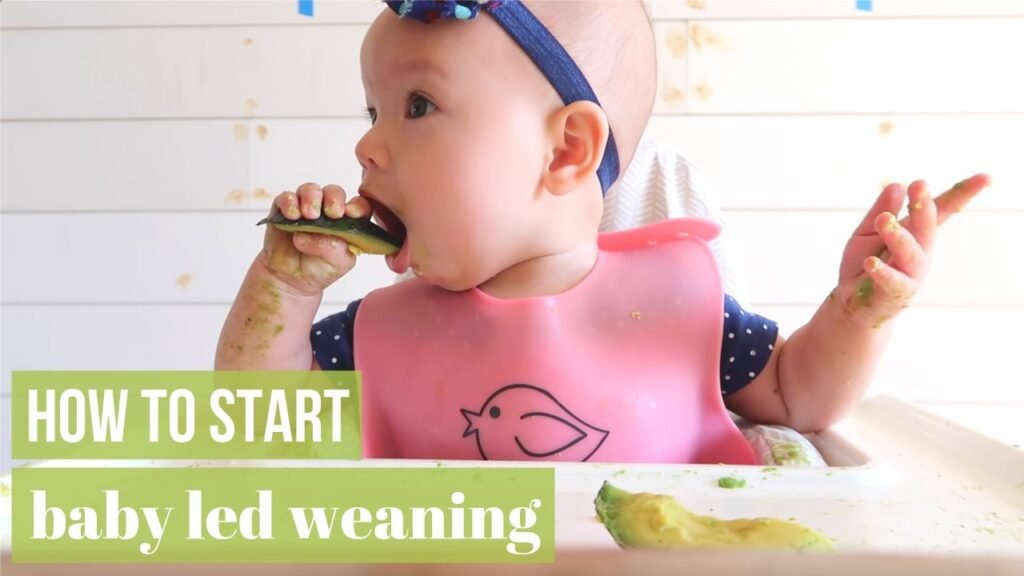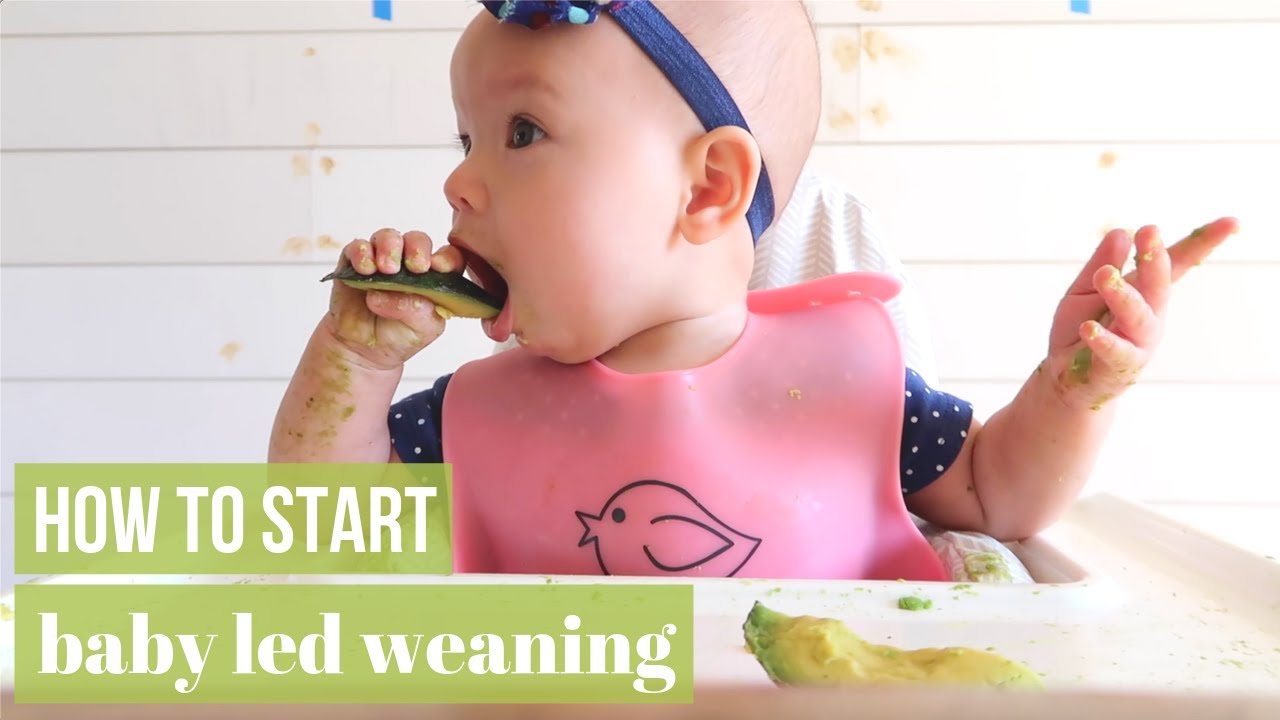Hey there! Have you heard about Baby Led Weaning? In this informative article, you’ll learn all about introducing solid finger foods to your baby. From the tools needed to the preparation methods, you’ll find everything you need to know to start this exciting journey with your little one. Reading about Ashley’s experience with her baby, Mia, will give you valuable insights and tips for successful baby-led weaning. Remember, no special tools are required, but some essentials like bibs and child-size utensils may come in handy. Start with one meal per day and follow the progression of foods to ensure a seamless transition for your baby.
Are you ready to venture into the world of Baby Led Weaning? Follow along with Ashley as she shares her journey with introducing solid finger foods to her six-month-old baby, Mia. Discover the benefits of skipping purees and going straight to delicious, squishy foods that your baby can gum and swallow. With helpful tips and recommendations, you’ll be well-equipped to embark on this exciting adventure of baby-led weaning. Remember to offer water with meals, avoid processed foods, and introduce meats in finger-sized pieces. Get ready to watch your baby explore and enjoy the wonderful world of solid foods!
Overview of Baby Led Weaning
If you’re considering Baby Led Weaning (BLW) for your little one, it’s essential to understand the concept, benefits, and key principles associated with this feeding approach.
Explanation of Baby Led Weaning concept
Baby Led Weaning is a method of introducing solid foods to babies that skips purees and allows babies to self-feed with finger foods. This approach promotes independence in eating and encourages babies to explore different textures and tastes from the start.
Benefits of Baby Led Weaning
The benefits of BLW include promoting fine motor skills, encouraging healthier eating habits, fostering a positive relationship with food, and reducing picky eating behaviors. Additionally, BLW allows babies to control their own intake, promoting self-regulation and reducing the risk of overfeeding.
Key principles of Baby Led Weaning
Some key principles of BLW include offering a variety of nutritious foods, respecting your baby’s cues and appetite, practicing responsive feeding, and ensuring a safe eating environment for your little one to explore and enjoy mealtime.
Getting Started
When you’ve decided to start Baby Led Weaning, knowing when to start, recognizing signs of readiness, gathering necessary tools, and preparing for the first BLW meal are crucial steps in the process.
When to start Baby Led Weaning
Most babies are developmentally ready to begin BLW around six months of age when they can sit up unassisted, show interest in food, and bring food to their mouth. It’s essential to consult with your pediatrician before starting solid foods to ensure your baby is ready.
Signs that your baby is ready for solids
Look for signs such as sitting up without support, showing an interest in what others are eating, reaching for food or objects, and displaying the ability to bring food to their mouth. These cues indicate that your baby may be ready to start exploring solid foods.
Tools needed for Baby Led Weaning
While not essential, some helpful tools for BLW include bibs to catch messes, a crinkle cutter for safe food shapes, child-size utensils for self-feeding, and silicone mats to secure plates and bowls during meals.
Preparing for the first BLW meal
Before introducing solid foods, ensure that your baby can safely sit up and show curiosity about food. Start with soft foods that can be squished between your fingers, such as avocado or banana, and cut them into manageable finger-sized pieces for your baby to grasp.
Choosing the Right Foods
Selecting appropriate first foods, introducing various food groups, and knowing which foods to avoid are important considerations when starting BLW.
Ideal first foods for Baby Led Weaning
Ideal first foods for BLW include easy-to-grasp fruits and vegetables like avocado, sweet potato, or steamed broccoli. Soft foods that can be easily squashed are recommended to help babies gum and swallow safely.
Introduction to different food groups
Introduce a variety of food groups to ensure balanced nutrition for your baby. Include fruits, vegetables, whole grains, dairy, and proteins in their diet to provide essential nutrients for growth and development.
Foods to avoid during BLW
Avoid foods that pose a choking hazard, such as whole nuts, large chunks of raw vegetables, popcorn, hard candies, and sticky foods like marshmallows. Additionally, limit high-sugar and high-sodium processed foods in your baby’s diet.

Safety Measures
Keeping your baby safe during mealtimes is paramount when practicing Baby Led Weaning. Implementing tips to prevent choking, knowing how to react in case of a choking incident, and considering CPR training for parents are essential safety measures to be aware of.
Tips for preventing choking during BLW
To reduce the risk of choking, cut foods into appropriate sizes for your baby’s developmental stage, supervise meals closely, encourage chewing before swallowing, and discourage distractions during feeding time.
Steps to take in case of a choking baby
In the event of a choking baby, it’s crucial to remain calm and act quickly. Learn how to perform infant CPR and first aid for choking, as prompt action can save a baby’s life in an emergency situation.
Importance of CPR training for parents
Consider attending a CPR and first aid training course specific to infants and children to equip yourself with life-saving skills and knowledge. Being prepared for emergencies can provide peace of mind and ensure your ability to respond effectively when needed.
Ashley’s Baby Led Weaning Journey
Meet Ashley and her baby Mia, as they embark on their Baby Led Weaning journey. Discover Ashley’s personal experience, tips, and tricks for successful BLW with her six-month-old daughter.
Introduction to Ashley and her baby Mia
Ashley, a mother of two girls, shares her experience with Baby Led Weaning and her decision to introduce this feeding approach to her youngest daughter, Mia, as she reaches the age for starting solid foods.
Personal experience with BLW
Ashley discusses her journey with BLW, detailing her methods, challenges, and successes in introducing Mia to a variety of finger foods and encouraging independent eating habits from an early age.
Tips and tricks for successful BLW
Drawing from her practical experience, Ashley offers valuable tips and tricks for parents considering Baby Led Weaning for their babies. From meal planning to safety precautions, Ashley shares insights to help make the BLW process enjoyable and beneficial for both parent and child.
Essential Tools and Equipment
While you don’t need specialized equipment for BLW, certain tools can enhance the experience and make mealtimes more manageable. Consider investing in bibs, a crinkle cutter, and child-size utensils to aid your baby in self-feeding.
Bibs for messy eaters
Waterproof bibs with pockets are ideal for catching spills and food debris during BLW meals. Choose bibs that are easy to clean and adjustable to fit your baby comfortably.
Crinkle cutter for safe food shapes
A crinkle cutter can help create textured food shapes that are easy for babies to grasp and chew. Using a crinkle cutter can also add visual appeal to meals and make foods more enticing for your little one.
Child-size utensils for self-feeding
Child-size spoons and forks designed for little hands can encourage independence and fine motor skills in babies as they learn to feed themselves. Opt for safe, BPA-free utensils that are easy for babies to hold and use.
Progressing with Meals
As your baby grows and becomes more adept at self-feeding, gradually increase meal frequency, adjust portion sizes based on appetite, and ensure mealtime progression aligns with your baby’s developmental stage.
Starting with one meal a day
Begin with offering one meal a day to practice Baby Led Weaning. Choose a time when your baby is alert and hungry, and introduce a variety of foods to stimulate their senses and explore different flavors and textures.
Increasing meal frequency as baby grows
As your baby shows interest and readiness, gradually increase the frequency of meals to accommodate their growing appetite and evolving nutritional needs. Aim to provide three meals a day by the time your baby reaches nine months of age.
Adjusting portion sizes based on baby’s appetite
Allow your baby to guide meal portions by watching for hunger cues, such as reaching for more food, turning away when full, or showing signs of satisfaction. Avoid pressuring your baby to eat more than they desire and respect their individual appetite and preferences.
Offering Water and Drinks
In addition to solid foods, offering water with meals, preventing constipation in babies, and knowing which drinks to avoid during BLW are essential considerations for promoting hydration and overall well-being.
Importance of offering water with meals
Encouraging your baby to drink water with meals can help prevent dehydration, aid digestion, and establish healthy hydration habits from an early age. Offer small sips of water in a safe cup or bottle to introduce your baby to drinking independently.
Preventing constipation in babies
To prevent constipation when starting BLW, ensure your baby consumes an adequate amount of fiber-rich foods, stays hydrated with water, and maintains regular bowel movements. Introduce prunes, pears, peas, or other fiber-packed foods to support healthy digestion.
Types of drinks to avoid during BLW
Avoid giving sugary beverages, fruit juices, caffeinated drinks, and carbonated sodas to babies during BLW. Opt for water as the primary beverage and limit other drinks that may displace essential nutrients from solid foods in your baby’s diet.
Introduction of Meats and Proteins
When incorporating meats and protein-rich foods into your baby’s BLW diet, focus on safely introducing finger-sized pieces, exploring diverse protein sources, and preparing nutritious meals to support your baby’s growth and development.
Safely introducing meats in finger-sized pieces
When introducing meats to your baby, ensure they are cooked thoroughly, cut into manageable finger-sized pieces, and free from bones, skin, or excess fat. Soft meats like shredded chicken, ground turkey, or meatballs are suitable choices for BLW.
Protein-rich foods suitable for BLW
Include a variety of protein-rich foods in your baby’s BLW diet, such as beans, lentils, tofu, eggs, fish, and lean meats. These foods provide essential nutrients like iron, zinc, and amino acids necessary for healthy growth and development.
Recipes for protein-packed meals for babies
Experiment with simple and nutritious recipes that incorporate protein-rich ingredients for your baby’s BLW meals. Consider dishes like lentil soup, scrambled eggs, bean burgers, or salmon bites to introduce new flavors and textures to your baby’s palate.
Recommended Resources
For further guidance and support on Baby Led Weaning, explore additional resources, online communities, workshops, and classes that provide valuable information and tips for parents interested in adopting the BLW approach.
Further reading on Baby Led Weaning
Explore books, articles, and research studies on BLW to deepen your understanding of the feeding method, its benefits, and practical tips for implementing BLW successfully with your baby.
Online communities and support groups for BLW
Engage with online forums, social media groups, and parenting websites dedicated to Baby Led Weaning to connect with other parents, share experiences, and seek advice from a supportive community of BLW enthusiasts.
Workshops and classes for parents interested in BLW
Consider attending workshops, webinars, or parenting classes that focus on Baby Led Weaning to enhance your knowledge, gain hands-on experience, and interact with experts in infant nutrition and feeding practices. Participating in educational sessions can boost your confidence and skills in implementing BLW with your baby effectively.

